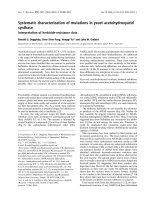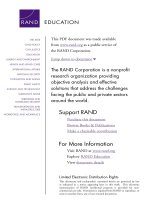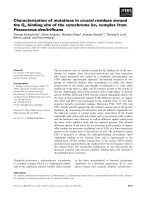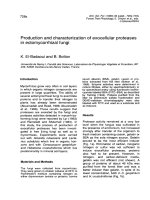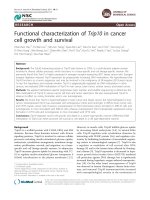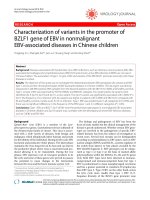Characterization of the novel role of parkin in gliomagenesis
Bạn đang xem bản rút gọn của tài liệu. Xem và tải ngay bản đầy đủ của tài liệu tại đây (2.85 MB, 182 trang )
CHARACTERIZATION OF THE NOVEL ROLE OF PARKIN IN
GLIOMAGENESIS
YEO WEE SING
M. Sc, NUS
A THESIS SUBMITTED
FOR THE DEGREE OF DOCTOR OF PHILOSOPHY
DEPARTMENT OF PHYSIOLOGY
YONG LOO LIN SCHOOL OF MEDICINE
NATIONAL UNIVERSITY OF SINGAPORE
2011
I
ACKNOWLEDGEMENTS
My thanks to God for His love so that I could complete this project.
My many sincere thanks, utmost gratitude and appreciation to my supervisor,
Associate Professor Lim Kah Leong for his great patience, invaluable guidance,
encouragements and wisdom throughout the course my Ph.D. studies, his passion and
love for science had greatly changed my view of how difficult but yet satisfying the
pursue of science can be.
My thanks to Associate Professor Ang Beng Ti, Dr Carol Tang, for their endless
guidance and encouragements in the various aspects of my project particularly the
animal work component.
Many thanks to Associate Professor Lim Tit Meng for his many encouragements and
support towards my Ph.D. work.
My thanks to the Singapore Millennium Foundation for awarding me a SMF Ph.D.
scholarship for my Ph.D. study.
My thanks to Felicia Ng for the tremendously amount of support she has given me for
the analysis of the microarray and bioinformatics data.
My thanks to Miss Katherine Chew for all the technical advices and artworks in my
thesis.
My thanks to my family, especially my dad and mum for all the encouragements and
support they have given me.
My thanks to my church friends and DG friends, Vivian, Yin, Luke, Pei Theng, Wei
San, Audrey, Jackie, Karen, Aileen, Ling Hong, David, Evon for the countless
encouragements and support.
Many thanks to my past and present labmates (Jeanne, Chee Hoe, Huiyi, Chai Chou
Esther, Eugenia, Shiam Peng, Eugenia, Xiao Hui, Hui Mei, Grace, Cheng Wu,
Melissa, Saheen, Cherlyn, Zhengshui) and colleagues (Hanchi, Priya, Irene, Alex,
Kok Poh, Dr Liao Ping, Lydiana, Tan Boon, Yuk Kien, Lynette, Charlene, Geraldine,
Esther, Kimberly, Joan, Bryce, Zhirong) at the National Neuroscience Institute for all
the encouragements, support, wonderful discussions and meals we had together.
Yeo Wee Sing, Calvin
2011
“Trust in the LORD with all your heart
and lean not on your own understanding;
in all your ways submit to him,
and he will make your paths straight.” Proverbs 3:5-6
II
TABLE OF CONTENTS
Acknowledgements I
Table of contents II
List of Figures VI
List of Tables VIII
Abbreviations VIII
Summary IX
Chapter I Introduction 1
1.1 Gliomas 1
1.2 Glioma Prevalence and Epidemiology 2
1.3 Glioma Clinical Presentation and Imaging 2
1.4 Glioma Classification and Grading 5
1.5 Glioma Databases 6
1.5.1 REMBRANDT 7
1.5.2 TCGA (The Cancer Genome Atlas) 7
1.6 Intervention and Treatment of Glioma 8
1.6.1 Radiotherapy 9
1.6.2 Surgical Resection 9
1.6.3 Chemotherapy 10
1.6.4 Targeted Molecular Therapy 11
1.7 Glioma Pathogenesis and Signaling Pathways 13
1.7.1 Cell Cycle Signaling pathways 13
1.7.2 Retinoblastoma (RB) Signaling pathway 16
1.7.3 p53 Signaling pathway 17
1.7.4 Growth Factor-Regulated Signaling Pathway 18
1.7.5 Epidermal Growth Factor Receptor Signaling Pathway 18
1.7.6 Platelet-derived Growth Factor Receptor Pathway 19
1.7.7 Fibroblast Growth Factor Receptor Pathway 21
1.7.8 Vascular Endothelial Growth Factor Signaling Pathway 21
1.7.9 Mitogenic Signaling Pathways 23
1.7.10 MAPK Signaling Pathway 23
1.7.11 PI3K/PTEN/Akt Signaling Pathway 25
1.7.12 MicroRNAs 27
1.7.12.1 MicroRNA-21 (miR-21) 28
1.7.12.2 MicroRNA-155 (miR-155) 30
1.8 Ubiquitin and E3 ligases in Cancer 31
1.9 Parkinson’s Disease (PD) and Cancer 35
1.10 Parkin 37
1.10.1 Genetic Organisation and Regulation of Parkin 37
1.10.2 Distribution and Expression of Parkin 38
1.10.3 Structure and Function of Parkin 39
1.10.4 Mutations in Parkin 41
1.11 Parkin and Cancer 43
1.12 Cyclin E – A link between parkin, cancer and neurodegeneration? 45
1.13 Other PD-linked Genes and Cancer 48
1.15 A role for parkin in gliomagenesis – Project Aims and
III
Rationales 51
Chapter 2 Materials and Methods 54
2.1 Materials 54
2.1.1 cDNAs 54
2.1.2 Antibodies 54
2.1.3 Cell lines 55
2.2 Methods 55
2.2.1 Cell Culture 55
2.2.2 Preparation of primary MEFs 56
2.2.3 Cryopreservation of culturing cells 56
2.2.4 Thawing of cryopreserved cells 57
2.2.5 Transfection of U-87MG using Invitrogen Plus
™
and lipofectamine
™
reagents 57
2.2.6 Preparation of electrocompetent cells for
Electroporation 58
2.2.7 Electroporation of electrocompetent cells 59
2.2.8 Extraction of plasmid 60
2.2.9 Creation of vector control, human wild type parkin and
mutant parkin, T415N stables in U-87MG glioma cell line 60
2.2.10 Total RNA extraction using Qiagen RNeasy® Mini Kit 62
2.2.11 Reverse-transcription of total RNA using
Invitrogen SuperScript™ II Reverse Transcriptase 63
2.2.12 Real-Time Polymerase Chain Reaction
(Real-Time PCR) 63
2.2.13 Assessment of cellular proliferation using simple
cell count by haemocytometer 64
2.2.14 Assessment of cellular proliferation using
Roche Cell proliferation Kit I (MTT) 65
2.2.15 Assessment of cellular proliferation using Roche
5-Bromo-2’-deoxy-uridine Labeling and
Detection Kit I (BrdU) 66
2.2.16 Soft-Agar colony formation assay 67
2.2.17 Cell cycle analysis via DNA content analysis
using propidium iodide 67
2.2.18 Immunocytochemistry and confocal microscopy 68
2.2.19 Cell lysis, western blotting and immunoblotting 69
2.2.20 Cell cycle analysis via BrdU 71
2.2.21 Flank and NOD-SCID/J Intracranial mouse tumor model 72
2.2.22 NOD-SCID/J Intracranial mouse survival assay 73
2.2.23 Microarray 74
2.2.24 Bioinformatic analysis of microarray data 75
Chapter 3 Parkin mitigates the rate of glioma cell proliferation in in vitro
and in vivo 77
3.1 Overview 77
3.2 Results 78
3.2.1 Ectopic parkin expression in parkin-deficient MCF7
breast cancer cells mitigates their proliferation in vitro
and in vivo. 78
IV
3.2.2 Parkin expression is downregulated in various glioma
cell lines. 81
3.2.3 Parkin is uniformly localized in the cytoplasm of
various glioma cell lines 82
3.2.4 Ectopically-expressed parkin mitigates the rate of
proliferation of parkin-deficient U-87MG
glioma cells in vitro 83
3.2.5 T415N mutant parkin expression in U-87MG glioma
does not affect rate of cellular proliferation 85
3.2.6 Parkin expression in U-87MG cells reduces their
ability to generate tumor in vivo 86
3.2.7 Parkin expression in U-87MG cells exhibit significantly
improved survival of NOD-SCID mice as compared to
U-87MG vector control 88
3.3 Discussion 89
Chapter 4 Parkin mitigates cell cycle progression through regulation of
cell cycle regulatory machinery and PI3K/Akt cellular
survival pathway 92
4.1 Overview 92
4.2 Results 94
4.2.1 Parkin expression in U-87MG cells mitigates cell cycle
progression in asynchronized U-87MG cell line 94
4.2.2 Parkin expression in U-87MG cells mitigates cell cycle
progression in synchronized U-87MG cell line and
reduces levels 95
4.2.3 Parkin expression in U-87MG cells reduces cyclin D1
but not cyclin E levels 95
4.2.4 Akt phosphorylation is elevated in glioma cells 97
4.2.5 Akt Ser-473 phosphorylation is significantly reduced in
parkin-expressing glioma cells. 97
4.2.6 Parkin downregulates levels of phosphorylated-Akt
(Ser 473) under epidermal growth factor
(EGF)-stimulation 99
4.2.7 Parkin catalytic mutant T415N does not affect the
levels of phosphorylated-Akt (Ser 473) under
epidermal growth factor (EGF)-stimulated condition
in U-87MG cell line 100
4.2.8 Parkin null fibroblasts exhibit enhanced proliferation
rate that is mitigated by parkin expression restoration 101
4.2.9 Expression of cyclin D1 and phospho-Akt are
upregulated in parkin null fibroblasts but is suppressed
following parkin expression restoration. 102
4.3 Discussion 104
Chapter 5 Parkin pathway activation predicts survival outcome
of glioma patients 108
5.1 Overview 108
5.2 Results 110
V
5.2.1 Parkin expression in U-87MG cells significantly
affects global gene expression as compared to the
vector control 110
5.2.2 VEGFR-2 expression are significantly reduced
in parkin-expressing glioma cells 111
5.2.3 Interleukin 13 receptor is significantly upregulated
in parkin-expressing U-87MG cells 113
5.2.4 Other notable gene expression changes in
parkin-expressing-U87MG cells 114
5.2.5 Parkin expression downregulates levels of microRNA-21
(miR-21) and microRNA-155 (miR-155) in glioma cells 115
5.2.6 Parkin expression correlates inversely with glioma
mortality 117
5.2.7 Refining microarray data 118
5.2.8 Parkin gene signature predicts survival outcome of
human glioma patients 120
5.3 Discussion 124
Chapter 6 General Discussion and Conclusions 127
6.1 A role for parkin in gliomagenesis – From brain degeneration
to brain cancer 127
6.2 Parkin mitigates cell cycle progression at the G1-S phase
transition through the downregulation of cyclin D1 level 129
6.3 Expression of catalytically active parkin selectively reduces
levels of Akt phosphorylation at Ser 473 in U-87MG cells 130
6.4 Parkin expression reduces the levels of VEGFR2 and FKBP5 in
U-87MG cells 131
6.5 Parkin expression reduces the levels of oncogenic miR-21 and
miR-155 in U-87MG cells 133
6.6 Parkin gene signature predicts survival outcome of human
glioma patients 133
6.7 Conclusions 136
6.8 Future Work 138
Chapter 7 References 139
Publications 171
VI
LIST OF FIGURES
1.1 Distribution of the different types of gliomas (Graph from Central Brain
Tumor Registry of the United States, CBTRUS) 2
1.2 MRI scan of a 51-year old man with frontal glioblastoma multiforme
which shows a centrally necrotic frontal lobe mass with edema. 3
1.3 DWI scans of different WHO grades astrocytomas. 4
1.4
1
H-MRS imaging of 59 year-old woman with superior frontal
anaplastic astrocytomas. 5
1.5 REMBRANDT knowledge database 7
1.6 Stages of the cell cycle with the various regulators. 14
1.7 Altered signaling pathways in the development of malignant gliomas 17
1.8 MAPK signaling pathway in growth and differentiation 24
1.9 Protein Ubiquitination 33
1.10 The Relative Risk of Cancer from various sites in both men and
women with Parkinson’s Disease 36
1.11 Parkin exon structure and various mutations 42
1.12 Genomic Deletion Profile of human chromosome 6 from a panel of 746
cancer cell lines 43
1.13 The Identification of significant arm-level and focal SCNAs across the
panel of cancers 44
3.1 Over expression of parkin in MCF-7 cells mitigates their
proliferation rate 79
3.2 Parkin expression mitigates MCF-7 cancer cell growth in vivo 80
3.3 Parkin expression is down-regulated in various glioma cell lines 82
3.4 Parkin is uniformly localized in the cytoplasm in various glioma cell lines 83
3.5 Over expression of parkin in U-87MG glioma cells mitigates their
proliferation rates 84
3.6 Over expression of T415N mutant parkin in U-87MG glioma cells do
not affect their rate of cellular proliferation as compared to the
vector control 86
3.7 Parkin expression in U-87MG cells reduces their ability to generate
tumor in vivo 87
3.8 Parkin expression correlates inversely with cancer mortality in a
mouse model of glioma 89
4.1 Parkin expression in U-87MG cells mitigates cell cycle progression
in asynchronized U-87MG cell line 94
4.2 Parkin overexpression in U-87MG cells delays entry of synchronized
U-87MG cells into mitotic phase 95
4.3 Parkin overexpression in U-87MG cells reduces the level of cyclin D1 96
4.4 Phospho-Akt expression in various glioma cell lines 97
4.5 Phosphorylation of Akt at Ser-473 is significantly repressed in
parkin-expressing U-87MG cells 98
4.6 Phosphorylation of Akt at Thr-308 is unaffected in parkin-expressing
U-87MG cells 98
4.7 Parkin downregulates levels of phosphorylated-Akt (Ser 473) even
under epidermal growth factor (EGF)-stimulated condition in
U-87MG cell line 99
VII
4.8 Parkin mutant T415N does not affect the levels of phosphorylated-Akt
(Ser 473) under EGF-stimulated condition in U-87MG cell line 101
4.9 Restoration of parkin expression in parkin null fibroblasts reduces
their proliferation rate 102
4.10 Parkin null MEFs exhibit enhanced expression of cyclin D1 and
phospho-Akt 103
4.11 Parkin expression restoration in parkin -/- MEFs suppresses expression
of cyclin D1 and phospho-Akt 103
5.1 Principal component analysis (PCA) plot showing different
transcriptional profile of genes between the parkin expressing U-87MG
cells and their respective vector controls. 110
5.2 Parkin gene signature 111
5.3 VEGFR-2 expression is downregulated in parkin-expressing
U-87MG cells 112
5.4 IL-13Rα2 expression is upregulated in parkin-expressing U-87MG cells 113
5.5 Parkin expression downregulates the levels of FKBP5 in U-87MG
cell line as compared to the vector control 114
5.6 Parkin expression downregulates levels of microRNA-21
(miR-21) and microRNA-155 (miR-155) in U-87MG cell line as
compared to the vector control as verified by Real-Time
polymerase chain reaction (PCR) 116
5.7 PARK2 expression is consistently low in all tumor grades when
compared to ‘non-tumor’ 117
5.8. Low PARK2 expression portends poor prognosis 118
5.9 Microarray analysis of gene expression changes in parkin expressing
U-87MG cells are compared to their vector controls 119
5.10 Parkin gene set enrichment and network analysis 121
5.11 Parkin gene signature is predictive of survival outcome of human
glioma patients 123
6.1 Proposed model of parkin’s anti-proliferative effects in gliomas 138
VIII
LIST OF TABLES
1 Overview of current treatments for malignant gliomas 8
2 List of parkin substrates/ putative substrates 46
3 Genetic Determinants at the interface of neurodegeneration and cancer 48
ABBREVIATIONS
ATP Adenosine Triphosphate
CDK Cyclin-dependent kinase
CSF Cerebral-spinal fluid
DMEM Dulbecco’s Modified Eagle’s Medium
DMSO Dimethyl sulfoxide
EGFR Epidermal growth factor receptor
ERK Extracellular signal-regulated kinase
FAK Focal adhesion kinase
FGFR Fibroblast growth factor receptor
GBM Glioblastoma multiforme
GFAP Glial fibrillary acidic protein
HNRNPK Heterogeneous nuclear ribonucleoprotein K
HSP Heat Shock Protein
JMY Junction-mediating and regulatory protein
LPS Lipopolysaccharide
MAPK Mitogen-activated protein kinase
MMP Matrix metalloproteinases
MRI Magnetic resonance imaging
OLIG2 Oligodendrocyte transcription factor 2
PDCD4 Programmed cell death 4
PDGFR Platelet-derived growth factor receptor
PTEN Phosphatase and tensin homolog
RB Retinoblastoma
RING Really Interesting New Gene
RTK Receptor tyrosine kinase
IX
SDS-PAGE Sodium dodecyl sulfate polyacrylamide gel electrophoresis
TP53BP2 Tumor protein p53 binding protein 2
TPM1 Tropomyosin 1
VEGFR Vascular endothelial growth factor receptor
SUMMARY
Parkin was originally discovered as a gene whose mutations are causative of
familial parkinsonism. However, numerous subsequent evidences suggest that parkin
also plays a role in the progression and development of a variety of cancer.
In this thesis, I investigated the potential role of parkin in gliomagenesis and
showed that parkin expression is dramatically reduced in glioma cells. I further
showed that restoration of parkin expression in these cells promotes their arrest at G1
phase and significantly mitigates their proliferation rate both in vitro and in vivo.
Notably, the level of cyclin D1, but not cyclin E, is reduced in parkin-expressing
glioma cells. Moreover, parkin expression also leads to a selective downregulation of
Akt serine-473 phosphorylation and VEGF receptor 2 levels. Supporting this, cells
derived from parkin null mouse exhibit increased levels of cyclin D1, VEGF receptor
2 and Akt phosphorylation and divide significantly faster compared to their wild type
counterparts, all of which are suppressed following the re-introduction of parkin into
these cells. However, parkin-mediated effects on these components is dependent on
its catalytic competency as a catalytically null parkin mutant failed to influence the
expression of cyclin D1, phospho-Akt and VEGF receptor. Interestingly, parkin
expression also leads to the downregulation of two oncogenic microRNAs namely
miR-21 and miR-155. Importantly, analysis of parkin pathway activation revealed its
predictive power for survival outcome of glioma patients.
X
Taken together, my study provides a mechanism by which parkin exerts its
tumor suppressor function and a signature pathway of parkin that is of potential
prognostic value.
Introduction 1
CHAPTER 1
INTRODUCTION
1.1 Gliomas
Gliomas are cancer of the glial cells and are among the most difficult
cancers to treat because of the limited selection of anticancer drugs that could
permeate through the blood brain barrier to reach the tumors. Although gliomas
are considered as a rare disease with an incidence rate of about 1-2% as compared
to other types of cancer, there is a high rate of recurrence even after complete
surgical removal of the tumor. In addition to this, the median rate of survival of
malignant glioma is usually about 12 months (Maher et al., 2001). Thus, it is
important to understand the disease better in order to treat it more effectively.
Broadly, gliomas include astrocytomas, ependymomas, medulloblastomas,
meningiomas, oligodendrogliomas and pituitary adenomas. Astrocytomas are glial
tumors derived from the star-shaped glial cells that are normally involved in
several vital processes including neurotransmitter uptake and release,
vasomodulation, and modulation of synaptic transmission (Kanu et al., 2009).
Ependymomas are derived from cuboidal ependymal cells which line the
cerebrospinal fluid (CSF)-filled ventricles in the brain and the central canal of the
spinal cord (Gilbert et al., 2010), whereas oligodendrogliomas are derived from
myelin forming cells of the central nervous system (Wen et al., 2008).
Medulloblastomas are usually located around the region from the cerebellum to
brain stem and they represent about 20% pediatric and adult brain tumors.
Meningiomas are tumors that develop in the meninges covering the central
Introduction 2
nervous system and it accounts for about 25% of all primary brain tumors. Finally,
pituitary adenomas are usually benign tumors of the pituitary gland and they
represent about 10% of all primary brain tumors.
1.2 Glioma Prevalence and Epidemiology
The annual incidence of malignant gliomas is approximately 5 cases per
100,000 people (Louis et al., 2007). Malignant gliomas refers to the metastatic
gliomas which are the WHO classified grade III and IV gliomas. The most
malignant type of glioma, glioblastoma multiforme (GBM) accounts for about
50% of malignant gliomas. Other forms of malignant gliomas include
astrocytomas and oligodendrogliomas, which together account for about 34% of
all gliomas. The remaining 5-10% consists of less common tumors such as
anaplastic ependymomas and gangliogliomas (Louis et al., 2007) (Fig. 1.1). The
word “anaplastic” refers to dedifferentiation which is a distinctive feature as the
cancer progresses to a more advanced stage.
Figure 1.1 Distribution of the different
types of gliomas (Graph from Central
Brain Tumor Registry of the United
States, CBTRUS)
The recorded incidence of gliomas has increased slightly over the past two
decades as a result of advances in diagnostic imaging techniques (Fisher et al.,
2007). The incidence of malignant gliomas is 40% more common in men as
Introduction 3
compared to women and twice as common in Caucasians compared to African
populations. The median age of onset in patients at the time of diagnosis is 64
years of age in the case of GBM and 45 years of age in the case of anaplastic
gliomas (Fisher et al., 2007). About 5% of patients with malignant gliomas exhibit
a family history of gliomas and a portion of these familial cases are associated
with rare genetic syndromes, such as Turcot’s syndrome, neurofibromatosis type 1
and 2 and the Li-Fraumeni syndrome (Farrell et al., 2007).
1.3 Glioma Clinical Presentation and Imaging
Patients with malignant gliomas may present with a variety of symptoms
including headaches, nausea, vomiting, confusion, seizures, memory loss, focal
neurological deficits and personality changes. Classical headaches observed in
glioma patients are indicative of increased intracranial pressure and are most
severe in the morning and may potentially cause insomnia for these patients.
The medical diagnosis of gliomas is usually confirmed by magnetic
resonance imaging (MRI) or computed tomography. These glioma imaging
studies conventionally show a heterogeneously enhanced mass with edema in the
surrounding cavity. In the case of GBMs, there are necrotic regions in the central
areas of the tumors and more extensive peritumoral edema compared to anaplastic
astrocytomas (Fig. 1.2) (Cha, 2006).
Figure 1.2 MRI scan of a 51-year old
man with frontal glioblastoma
multiforme which shows a centrally
necrotic frontal lobe mass with
edema. (A) Pre-operation MRI image.
(B) Post-operation MRI image. (Image
from Cha, 2006)
Introduction 4
MRI techniques like diffusion-weighted imaging (DWI) for tumor grade
assessment, dynamic contrast-enhanced MRI to measure blood vessel
permeability, perfusion-weighted imaging to measure relative cerebral blood
volume are used more frequently as diagnostic aids and for monitoring of
response to therapies (Young, 2007). DWI-MRI uses the principle that water
diffusivity within the extracellular compartment is inversely related to the
cellularity within the extracellular space. The basic principle of DWI-MRI
measurement is as follows: the higher the level of cellularity, the lower the water
diffusivity through the intracellular spaces between cells and hence a lower
apparent diffusion coefficient (ADC). Based on this, DWI-MRI is commonly used
to assess tumor grade (Fig. 1.3) and cellularity, post-operative injury, peritumoral
edema and integrity of the white matter tract.
Figure 1.3 DWI scans of different WHO grades astrocytomas. (Left) WHO grade II,
Middle) WHO grade III, (Right) WHO grade IV astrocytomas (Image from Cha, 2006).
There is also the use of proton magnetic resonance spectroscopy (
1
H-
MRS) to assist in the detection of the levels of metabolites and that could help to
differentiate proliferating tumors from benign and necrotic lesions. For this
imaging technique, samples from malignant glioma would show an increase in the
choline peak and a decrease in the N-acetyl aspartate peak as compared to
unaffected areas of the brain (Fig. 1.4A). These metabolites level changes have
Introduction 5
moderate to high sensitivity (64%-95%) and high specificity (82%-100%) for
identifying actively dividing tumors. In addition, the corresponding increase in
lactate, an end-product of nonoxidative glycolysis in regions of tumors may
correlate with hypoxia within the tumor tissues. However, this technique is not
able to distinguish between malignant and benign tumors (Fig. 1.4B) (Allen,
1972).
Figure 1.4
1
H-MRS imaging of 59 year-old woman with superior frontal anaplastic
astrocytomas. (A) The centre of tumor mass reveals a marked increase in lactate (Lac),
choline (Cho) and a decrease in N-acetyl aspartate (NAA) metabolite. (B) Corresponding
lactate metabolite peaks detected within the tumor regions. (Image from Cha, 2006).
1.4 Glioma Classification and Grading
Gliomas are classified and sub-categorized on the basis of
histopathological manifestations and clinical presentations. They are graded on a
World Health Organization (WHO) consensus-derived scale of I to IV according
to the degree of malignancy as determined by various histological features and
genetic alterations (Louis et al., 2007).
Introduction 6
According to WHO classification, Grade I gliomas are considered as
biologically benign and can be completely eradicated by surgical resection. Grade
II gliomas are low-grade malignant tumors that could potentially infiltrate
surrounding brain tissues rendering them incurable by surgery. The mean survival
rate for this group of patients is around 5 to 10 years. Grade III gliomas
demonstrate much enhanced proliferation, anaplasia and angiogenic responses
over grade II glioma with a mean survival rate of about 2 to 3 years. Finally, grade
IV glioma which is the most prevalent and biologically aggressive is defined by
hallmarks of unrestrained cellular proliferation, diffuse infiltration, increased
angiogenesis, propensity for necrosis, resistance to apoptosis and rampant
genomic instability. Grade IV gliomas are usually quite recalcitrant to
radiotherapy and chemotherapy. Patients with Grade IV gliomas have a mean
survival rate of around 9 to 14 months (Furnari et al., 2008). GBM (WHO grade
IV) is one of the most common and malignant type of brain tumor that accounts
for 50% of all incident cases of astrocytic and oligodendroglial tumors. Despite
advances in surgery, chemotherapy and radiation therapy, the median survival rate
remains dismal (about 12 months) (Bansal et al., 2006).
1.5 Glioma Databases
Towards better understanding and treatment of gliomas, a number of
databases that capture and integrate data associated with glioma studies have been
developed in recent years. Two of such glioma databases, Rembrandt and TGCA,
are briefly described below.
Introduction 7
1.5.1 REMBRANDT
REpository for Molecular BRAin Neoplasia DaTa (REMBRANDT) is
clinical glioma patients’ genomics database that leverages data warehousing
technology to host and integrate clinical and functional genomics data from
clinical trials involving patients suffering from gliomas. The knowledge
framework can be used to provide researchers with the ability to perform ad hoc
querying and reporting across multiple data domains, such as gene expression,
chromosomal aberrations and clinical data. To date, Rembrandt contains data
generated through the glioma diagnostic initiative from 1018 glioma specimens
comprising of 568 gene expression arrays and 920 copy number arrays.
Fig. 1.5 REMBRANDT
knowledge database (from
http://caintegrator-
info.nci.nih.gov/rembrandt)
Through the use of Rembrandt, one is able to trace the expression level of
a gene of interest in the various grades of glioma patients and its correlation with
survival rate. And at the same time, the database also provides a platform for
validation of gene signature derived from cellular or animal model studies.
1.5.2 TCGA (The Cancer Genome Atlas)
The Cancer Genome Atlas (TCGA) is another comprehensive and
coordinated effort by cancer researchers to accelerate the understanding of the
Introduction 8
molecular basis of cancer through the application of genome analysis technologies
and large-scale genome sequencing. As a public resource, all TCGA data are
deposited at the Data Coordinting Center for public access
( The first cancer that was studied by TCGA is
glioblastoma and this database provides a network view of the pathways altered in
the development of glioblastoma. Importantly, TCGA is able to integrate analysis
of DNA copy number, gene expression and DNA aberration data to come out with
a more defined core signaling pathways in glioblastoma in which we can compare
against in our own studies. The only caveat is that TCGA at this moment
comprises mainly GBM specimens and has thus less molecular heterogeneity than
Rembrandt, which contains information on gliomas at different stages.
1.6 Intervention and Treatment of Glioma
The care for glioma patients revolves around the management of common
set of problems faced by brain tumor patients which include seizures, venous
thromboembolism, cognitive dysfunction, fatigue and peritumoral edema (Wen et
al., 2006). The standard therapy for the treatment of malignant gliomas involves
radiotherapy, surgical resection and chemotherapy (Table 1).
TypesofTumors TherpeuticIntervention
Glioblastomas(WHO
gradeIV)
Maximalsurgicalresection,plusradiotherapy,plusconcomitant
adjuvantTMZorcarmustinewafers(Gliadel)
Anaplasticastrocytomas
(WHOgradeIII)
Maximalsurgicalresection,withradiotherapy,plusconcomitant
andadjuvantTMZorTMZalone
Anaplastic
oligodendrogliomaand
anaplastic
oligoastrocytomas(WHO
gradeII)
Maximalsurgicalresectionwithradiotherapyalone,TMZorPCV
withorwithoutradiotherapyafterward,radiotherapyplus
concomitantandadjuvantTMZ,orradiotherapyplusadjuvant
TMZ
Recurrenttumors
Reoperationinselectedpatients,carmustinewafers(Gliadel),
conventionalchemotherapy(e.g.lomustine,PCV,carmustine,
irinotecan,etoposide),bevacizumabplusirinotecan.
Introduction 9
Table 1. Overview of current treatments for malignant gliomas (From Wen et al.,
2008) temozolomide (TMZ), procarbazine (PCV), lomustine (CCNU).
1.6.1 Radiotherapy
Radiotherapy is the mainstream treatment of malignant gliomas and is
usually used in combination with surgery to increase the survival among glioma
patients from about 3 to 4 months to 7 to 12 months (Stupp et al., 2005). A typical
radiotherapy regime consists of 60 Gy of partial-field external-beam irradiation
delivered 5 days per week in portions of 1.8 to 2.0 Gy, which represents the
standard treatment for glioma patients after resection. Age appears to be an
important factor in determining the effectiveness of radiotherapy. Radiotherapy
performed on glioma patients who are 70 years of age or older produces only a
modest benefit in median survival of about 29.1 weeks as compared to supportive
care with a median survival of 16.9 weeks and elderly glioma patients generally
have a worse prognosis than their younger counterparts (Keime-Guibert et al.,
2007).
1.6.2 Surgical Resection
Surgical resection is the most common initial therapeutic approach for
obtaining tissues for diagnosis and for “tumor debulking” (i.e. surgical removal of
as much tumor tissues as possible) provided that neurological function is not
compromised. Although glioma patients undergo maximal surgical resection
whenever possible, malignant gliomas are usually infiltrative by nature and cannot
be completely eliminated surgically. The benefits of surgical debulking include
reduction of intracranial pressure that could result from the mass effect of the
Introduction 10
tumor and provides tumor tissues for molecular studies and histological diagnosis.
Advances in surgical technologies such as MRI-guided neuro-navigation,
intraoperative mapping (Asthagiri et al., 2007) and fluorescence-guided surgery
(Stummer et al., 2006) have increased the efficacy of surgical resection and
improved the safety of surgery.
1.6.3 Chemotherapy
Chemotherapy is gaining importance in the treatment of gliomas and is
frequently used in combination with radiotherapy. One of the more commonly
used chemotherapeutic drugs against gliomas is temozolomide. Temozolomide is
a DNA alkylating agent that is approved for use in adult patients with anaplastic
astrocytoma that failed to respond to other drug treatments. It is also approved for
use during and after radiation therapy for patients newly diagnosed with GBM.
The current first-line treatment for patients with glioblastoma is combined
radiotherapy and temozolomide, followed by monthly doses of temozolomide
after radiation treatment ends. The treatment of malignant gliomas using a
combination radiotherapy plus temozolomide as compared with radiotherapy
alone significantly increased the median survival from 12.1 months to about 14.6
months (Stupp et al., 2005). Further to this, the survival rate at 2 years among the
glioma patients who received radiotherapy and temozolomide is 16.1% greater
than the survival rate among patients who received radiotherapy alone (Stupp et
al., 2005).
Another chemotherapeutic drug, carmustine is commonly being used to
treat many types of brain tumors, including GBM, medulloblastoma, and
anaplastic astrocytoma. Carmustine or bis-chloronitrosourea is a mustard gas-
Introduction 11
related α-chloro-nitrosourea compound used as a DNA alkylating agent in
chemotherapy. It is usually administered into the vein via IV but can also be
delivered through a wafer implant (Gliadel), which is surgically placed into the
brain cavity after tumor removal. An interesting chemotherapeutic approach
involves the implantation of biodegradable polymers containing carmustine
(Gliadel Wafers, MGI Pharma) into the tumor bed to gradually kill off the residual
tumor cells after the resection of the tumor. The use of these carmustine-
containing polymers in patients with malignant gliomas in a randomized, placebo-
controlled trial was shown to significantly increase their median survival from
11.6 months to 13.9 months (Westphal et al., 2003).
Currently, anaplastic astrocytomas are treated with radiotherapy and either
concurrent with adjuvant temozolomide or with temozolomide alone in the case of
GBMs. However, despite optimal treatment, almost all malignant gliomas recur
with a median time of progression time of 6.9 months after treatment with
radiotherapy and temozolomide (Stupp et al., 2005). Despite intensive efforts in
research for novel therapies, there remains a need for improvements in the
treatment strategies of malignant gliomas.
1.6.4 Targeted Molecular Therapy
The increasing understanding of the molecular pathogenesis of malignant
glioma has produced a more directed use of targeted molecular therapies. The
main focus has been on inhibitors that target receptor tyrosine kinases like EGFR
(Rich et al., 2004), VEGFR (Batchelor et al., 2007) and PDGFR (Wen et al.,
2006) as well as inhibitors targeting intracellular signaling components such as the
PI3K/Akt signaling pathway. Interestingly, these inhibitors when used as a single
Introduction 12
agent often only exhibit modest activity with patient response rate of about 0 to
15% (Chi et al., 2007). This response to single tyrosine kinase inhibitor could be
attributed to coactivation of multiple tyrosine kinases together with redundant
signaling pathways thereby limiting the activity of single inhibitors (Stommel et
al., 2007).
As mentioned earlier, malignant gliomas are among the most vascularized
human tumors and thus making them ideal targets for angiogenesis inhibitors (Jain
et al., 2007). Irinotecan, one of the more common topoisomerase I inhibitor used
is activated by its hydrolysis to SN-38 and this leads to the inhibition of both
DNA replication and transcription. Bevacizumab, on the other hand, is a
humanized monoclonal antibody that binds to vascular endothelial growth factor
A to block angiogenesis, commonly used in a variety of cancers. A positive effect
was observed in one of the angiogenesis inhibitor studies when the treatment of
malignant gliomas using a combination of bevacizumab and irinotecan had
lowered the incidence of haemorrhage. This combined regimen also increased the
6 month rate of progression free survival from 21% to 46% as compared to
patients who were already receiving temozolomide treatment.
With the increasing understanding of the molecular pathogenesis of
gliomas, it may be possible in the future to select the most appropriate therapies
on the basis of the patient’s tumor genotype. In the sections below, I shall provide
an update on our current understanding regarding the molecular events
surrounding gliomagenesis.
Introduction 13
1.7 Glioma Pathogenesis and Signaling Pathways
Three major signaling pathways have been identified to contribute
significantly towards the onset of gliomagenesis (Funari et al., 2008): 1) cell cycle
signaling pathways, 2) growth factor-regulated signaling pathways and 3)
mitogenic signaling pathways. Cell cycle signaling pathways relevant to
gliomagenesis consist of the retinoblastoma and p53 signaling pathways which are
involved in the regulation of cell cycle progression in tumor cells. In the growth
factor-regulated signaling pathways, extracellular growth factors are involved in
the cellular signaling of cell proliferation and signaling pathways implicated in
promoting glioma development include those mediated by epidermal growth
factor (EGF), platelet-derived growth factor (PDGF), fibroblast growth factor
(FGF) and vascular endothelial growth factor (VEGF). And for mitogenic
signaling pathways involved in gliomagenesis, the mitogen-activated protein
kinase signaling pathway and the PI3K/PTEN/Akt signaling pathway are two
major downstream effectors that shall be discussed herein.
1.7.1 Cell Cycle Signaling pathways
The mammalian cell cycle is a highly conserved mechanism which is
conventionally divided into 4 phases: G1 (first gap phase), S (DNA synthesis
phase), G2 (second gap phase) and M (mitosis phase) (Murray et al., 1993). The
progression through the cell cycle is regulated by sequential expression, activation
and inhibition of cyclins, cyclin-dependent kinases (CDKs) and cyclin-dependent
kinase inhibitors (CDKIs). In proliferating cells, there are certain checkpoints
which functions as molecular switches that ensure certain critical events in the
respective phases are completed before entry into the next phase. If the cells were
Introduction 14
arrested at any of these checkpoints, they will either return back to G
0
, resting
phase, re-differentiate or die by apoptosis so as to ensure that the non-repairable
DNA are not passed onto the next progeny of a mutated cell (Fig. 1.6) (Nagy,
2000).
Figure 1.6 Stages of the cell cycle with the various regulators. Progression through cell
cycles is tightly regulated by cyclin/CDK complexes and their inhibitors.
The activation of the cell cycle proceeds after mitogenic stimulation. This
requires the synthesis of cyclin D, which binds to and activates CDK4 and CDK6
to allow the progression of the G1 phase of the cell cycle. The retinoblastoma
protein (Rb) (which normally binds and inactivates E2F) is then phosphorylated
by the active cyclin D-CDK4 or cyclin D-CDK6 complexes on serine residues at
positions 788 together with 795. Upon its phosphorylation, Rb is released from the
E2F transcription factor which results in trans-activation and de-repression of E2F
transcription factor-target genes required for S-phase entry (Liu et al., 2001). This
allows for the transcription of cyclin E by the E2F family members. Cyclin E then
interacts with and binds to CDK2 towards the end of the G1 phase to form an
active complex which further phosphorylates the Rb protein on threonine residues
